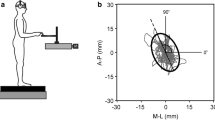Abstract
The purpose of the present experiment was to investigate whether and how using a light fingertip touch for postural control during quiet standing requires additional attentional demands. Nine young healthy university students were asked to respond as rapidly as possible to an unpredictable auditory stimulus while maintaining stable seated and upright postures in three sensory conditions: vision, no-vision and no-vision/touch. Touch condition involved a gentle light touch with the right index finger on a nearby surface at waist height. Center of foot pressure (CoP) displacements were recorded using a force platform. Reaction times (RTs) values were used as an index of the attentional demand necessary for calibrating the postural system. Results showed decreased CoP displacements in both the vision and no-vision/touch conditions relative to the no-vision condition. More interestingly, a longer RT in the no-vision/touch than in the vision and no-vision conditions was observed. The present findings suggest that the ability to use a light fingertip touch as a source of sensory information to improve postural control during quiet standing is attention demanding.


Similar content being viewed by others
References
Bateni H, Maki BE (2005) Assistive devices for balance and mobility: benefits, demands, and adverses consequences. Arch Phys Med Rehabil 86:134–145
Clapp S, Wing AM (1999) Light touch contribution to balance in normal bipedal stance. Exp Brain Res 125:521–524
Dickstein R, Shupert CL, Horak FB (2001) Fingertip touch improves postural stability in patients with peripheral neuropathy. Gait Posture 14:238–247
Holden M, Ventura J, Lackner JR (1994) Stabilization of posture by precision contact of the index finger. J Vestib Res 4:285–301
Jeka JJ (1997) Light touch contact as a balance aid. Phys Ther 77:476–487
Jeka JJ, Lackner JR (1994) Fingertip contact influences human postural control. Exp Brain Res 100:495–502
Jeka JJ, Lackner JR (1995) The role of haptic cues from rough and slippery surfaces in human postural control. Exp Brain Res 103:267–276
Kahneman D (1973) Attention and effort. Prentice-Hall, Englewood Cliffs
Lackner JR, Rabin E, DiZio P (2001) Stabilization of posture by precision touch of the index finger with rigid and flexible filaments. Exp Brain Res 139:454–464
Lajoie Y (2004) Effect of computerized feedback postural training on posture and attentional demands in older adults. Agin Clin Exp Res 16:363–368
Lajoie Y, Teasdale N, Bard C, Fleury M (1993) Attentional demands for static and dynamic equilibrium. Exp Brain Res 97:139–144
Lajoie Y, Teasdale N, Bard C, Fleury M (1996) Upright standing and gait: are there changes in attentional requirements related to normal aging? Exp Aging Res 22:185–198
Lee DN, Lishman JR (1975) Visual proprioceptive control of stance. J Hum Mov Stud 1:87–95
Redfern MS, Jennings JR, Martin, Furnam JM (2001) Attention influences sensory integration for postural control in older adults. Gait Posture 14:211–216
Riley MA, Stoffregen TA, Grocki MJ, Turvey MT (1999) Postural stabilization for the control of touching. Hum Mov Sci 18:795–817
Riley MA, Wong S, Mitra S, Turvey MT (1997) Common effects of touch and vision on postural parameters. Exp Brain Res 117:165–170
Shumway-Cook A, Woollacott M (2000) Attentional demands and postural control: the effect of sensory context. J Gerontol A Biol Sci Med Sci 55:M10–M16
Teasdale N, Bard C, LaRue, Fleury M (1993) On the cognitive penetrability of posture control. Exp Aging Res 19:1–13
Teasdale N, Simoneau M (2001) Attentional demands for postural control: the effects of aging and sensory reintegration. Gait Posture 14:203–210
Vuillerme N, Nougier V (2003) Effect of light finger touch on postural sway after lower-limb muscular fatigue. Arch Phys Med Rehabil 84:1560–1563
Vuillerme N, Nougier V (2004) Attentional demands for regulating postural sway: the effect of expertise in gymnastics. Brain Res Bull 63:161–165
Woollacott M, Shumway-Cook A (2002) Attention and the control of posture and gait: a review of an emerging area of research. Gait Posture 16:1–14
Wright DL, Kemp TL (1992) The dual-task methodology and assessing the attentional demands of ambulation with walking devices. Phys Ther 71:306–312
Wulf G, McNevin NH, Shea CH (2001) The automaticity of complex motor skill learning as a function of attentional focus. Q J Exp Psychol 54:1143–1154
Acknowledgements
The authors would like to thank D. Cath and B. Christelle for various contributions.
Author information
Authors and Affiliations
Corresponding author
Rights and permissions
About this article
Cite this article
Vuillerme, N., Isableu, B. & Nougier, V. Attentional demands associated with the use of a light fingertip touch for postural control during quiet standing. Exp Brain Res 169, 232–236 (2006). https://doi.org/10.1007/s00221-005-0142-7
Received:
Accepted:
Published:
Issue Date:
DOI: https://doi.org/10.1007/s00221-005-0142-7




